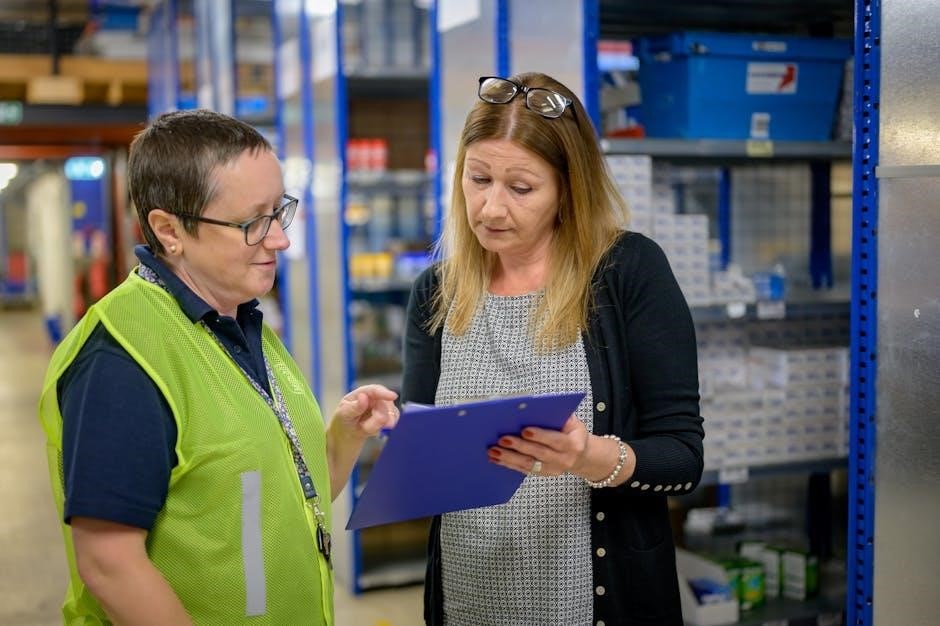A pre-trip inspection is essential for ensuring safety and compliance with regulations. It involves checking critical vehicle components, such as tires, brakes, lights, and fluids, to identify potential issues before driving. Using a pre-trip inspection checklist for Class A vehicles helps drivers systematically evaluate the vehicle’s condition, reducing risks and ensuring compliance with legal requirements. This process is a vital skill for CDL holders, as it promotes road safety and prevents mechanical failures during operation.
Importance of Pre-Trip Inspections
Pre-trip inspections are crucial for ensuring the safety of both the driver and other road users. They help identify potential mechanical issues before they lead to accidents or breakdowns. By systematically checking components like tires, brakes, lights, and fluids, drivers can address problems early, reducing the risk of costly repairs and delays. Regular pre-trip inspections also promote compliance with legal requirements, avoiding fines and penalties. Additionally, they contribute to better fuel efficiency and lower maintenance costs over time. A thorough inspection fosters a culture of safety and professionalism, making it an essential habit for all Class A vehicle operators. Using a pre-trip inspection checklist for Class A vehicles ensures no critical items are overlooked, providing peace of mind and helping drivers stay prepared for the road ahead.
Legal Requirements for Class A Vehicles
Class A vehicles are subject to strict legal requirements regarding pre-trip inspections. The Commercial Driver’s License (CDL) manual outlines specific protocols that must be followed to ensure compliance. These inspections are mandated to promote road safety and prevent mechanical failures. Drivers are legally required to inspect critical components such as brakes, tires, lights, and fluid levels before operating the vehicle. Failure to comply with these regulations can result in fines, penalties, or even license suspension. Additionally, a pre-trip inspection is a key component of the CDL skills test, and drivers must demonstrate proficiency in identifying and reporting defects. Using a pre-trip inspection checklist for Class A vehicles helps ensure all legal standards are met and reduces the risk of non-compliance. Regular inspections also align with federal and state transportation regulations, making them a critical part of a driver’s responsibility.

Preparing for the Pre-Trip Inspection
Organizing your checklist and tools beforehand ensures efficiency. Review the inspection sequence to cover all critical areas methodically. A structured approach helps identify potential issues early and ensures compliance with regulations.
Gather Necessary Tools and Documents
To perform a thorough pre-trip inspection, ensure you have the right tools and documents. Essential tools include a flashlight, tire pressure gauge, wheel chocks, and a reflective triangle. For documents, carry your commercial driver’s license (CDL), vehicle registration, insurance cards, and a copy of the pre-trip inspection checklist. Having these items readily available saves time and ensures compliance. Keep tools organized in a designated area, and store documents in a secure, easily accessible location. Familiarize yourself with the checklist to avoid missing critical inspection steps. Proper preparation helps identify potential issues early, reducing the risk of breakdowns or legal complications during transit. Always double-check that all required items are present before starting the inspection process.
Understanding the Pre-Trip Checklist

A pre-trip checklist for Class A vehicles is a detailed guide that ensures all critical components are inspected before hitting the road. It is designed to cover both the exterior and interior of the vehicle, as well as mechanical systems. The checklist typically includes sections for the front, sides, rear, and trailer, along with interior features like dashboard instruments, mirrors, and controls. It also addresses engine components, such as fluid levels, belts, hoses, and brakes, and tire and wheel condition. Understanding the checklist ensures you know what to inspect and how to document findings. Familiarize yourself with its layout to avoid missing any steps. A well-structured checklist helps identify potential issues early, ensuring safety and compliance with regulations. Consistently following it reduces the risk of mechanical failures and legal penalties during operation.

Exterior Inspection
The exterior inspection covers the front, sides, rear, and trailer, ensuring all lights, tires, and mirrors are in good condition. Check for damage or obstructions to guarantee safe operation.
Front of the Vehicle
Inspect the front of the vehicle for proper function and safety. Check headlights, fog lights, and turn signals to ensure they are clean and operational. Verify that the front grille and bumper are secure and free from damage. Examine the license plate for visibility and proper mounting. Test the air horns to ensure they are functioning correctly. Inspect the front tires for proper inflation, tread depth, and signs of wear. Check the fifth wheel and kingpin (if applicable) for proper lubrication and secure connection. Look for any leaks around the front axle or steering components. Ensure all front suspension parts are secure and not damaged. This step ensures the vehicle is roadworthy and visible to other drivers.
Right Side of the Vehicle
Inspect the right side of the vehicle for damage, wear, or obstructions. Check the tires for proper inflation, tread depth, and signs of uneven wear. Ensure the wheels are secure, and the lug nuts are tightened properly. Examine the brake chambers, hoses, and slack adjusters for damage or leaks. Verify that the mud flaps are properly attached and not damaged. Inspect the fuel tank and fuel cap for leaks or damage. Check the right side marker lights and reflectors to ensure they are clean and functional. Look for any dents, rust, or holes in the body panels. Ensure all decals and placards are visible and intact. This step helps identify potential issues that could affect safety or lead to breakdowns during transit.

Left Side of the Vehicle
Inspect the left side of the vehicle for damage, obstructions, or wear. Check the tires for proper inflation, tread depth, and signs of uneven wear. Ensure the wheels are secure, and the lug nuts are tightly fastened. Examine the brake chambers, hoses, and slack adjusters for damage or leaks. Verify that the mud flaps are properly attached and not damaged. Check the left side marker lights and reflectors to ensure they are clean and functional. Inspect the fuel tank and fuel cap for leaks or damage. Look for any dents, rust, or holes in the body panels. Ensure all decals and placards are visible and intact. This step ensures no issues are overlooked on the left side, which could pose safety risks or lead to mechanical failures during operation.
Rear of the Vehicle

Inspect the rear of the vehicle for damage or obstructions. Check the rear doors or cargo area for proper securement and ensure all latches and locks are functioning correctly. Verify that the rear lights, including brake lights, turn signals, and marker lights, are clean and operational. Inspect the rear reflective tape and mud flaps for damage or misalignment. Check the bumper and step area for damage or obstructions. Ensure the rear axle and suspension are secure and free from damage. Look for signs of fluid leaks around the rear axle or differential. Inspect the fifth wheel connection (if applicable) for proper securement to the trailer. Ensure all components are tight and free from wear. This step ensures the rear of the vehicle is safe and ready for operation, with no issues that could lead to mechanical failure or safety hazards.
Trailer Inspection
Inspect the trailer connection to the tractor, ensuring the fifth wheel and kingpin are securely locked. Check the trailer’s electrical connections, such as the seven-pin plug, for proper function and damage. Verify that all trailer lights, including brake lights, turn signals, and marker lights, are operational. Inspect the trailer tires for adequate tread depth and proper inflation, and check the wheels and rims for damage or looseness. Examine the brake system, including the slack adjusters and air hoses, for leaks or damage. Ensure the emergency brake system is functioning correctly. Check the trailer body for any signs of damage, dents, or rust. Verify that all cargo doors or gates are closed and securely latched. Ensure the trailer’s load is properly secured and balanced to prevent shifting during transit. This step ensures the trailer is safe and ready for towing without risking mechanical failure or cargo loss.

Interior Inspection
The interior inspection ensures the cabin is safe and functional. Check for damage, proper seatbelt operation, and ensure all controls, including brakes and steering, function correctly. Adjust mirrors and seats for comfort and visibility, and verify that all warning lights and alarms are operational. Ensure the fire extinguisher and first aid kit are present and easily accessible. Test the horn and heating/cooling systems for proper operation. Make sure the interior is free from obstacles that could interfere with driving. This step ensures a safe and comfortable driving environment, reducing the risk of accidents caused by interior malfunctions or distractions.
Dashboard and Instruments

Start by examining the dashboard and its instruments. Ensure all warning lights, such as the check engine, ABS, and airbag lights, are off. Test the horn to confirm it’s functioning properly. Check the odometer and trip odometer for accuracy. Inspect the gauges, including the speedometer, tachometer, oil pressure, coolant temperature, and fuel level, to ensure they are operating correctly. Verify that all dashboard indicators illuminate when the ignition is turned on. Look for any cracks or damage to the dashboard that could obstruct visibility or functionality. Ensure all buttons and switches, such as those for lights, wipers, and climate control, are working as intended. This step ensures that all critical systems are monitored and functional, allowing the driver to operate the vehicle safely and efficiently.
Seat and Mirrors Adjustment
Adjust the driver’s seat to a comfortable position, ensuring proper reach to the steering wheel and pedals. Check that the seatbelt is securely fastened and functional. Tilt and lumbar adjustments should support the driver’s posture to prevent fatigue during long drives. Next, adjust all mirrors, including the rearview, side mirrors, and any additional spot mirrors, to provide clear visibility around the vehicle. Ensure there are no obstructions blocking the view and that all mirrors are clean. Proper mirror alignment helps reduce blind spots, enhancing safety on the road. Finally, double-check that the mirrors stay in place while driving; This step ensures the driver has optimal visibility and comfort, which are crucial for safe operation of the vehicle.
In-Cab Controls and Systems
Check all in-cab controls and systems to ensure proper functionality. Start by testing the gauges, including the speedometer, tachometer, oil pressure, coolant temperature, and fuel level. Verify that all warning lights and indicators are functioning correctly. Test the heating, ventilation, and air conditioning (HVAC) system to ensure proper operation. Adjust the steering wheel and check its locking mechanism. Inspect the infotainment and navigation systems for clarity and connectivity. Test all switches, including hazard lights, fog lights, and wipers. Ensure the CB radio and other communication devices are operational. Finally, check the horn and verify that all emergency equipment, such as the fire extinguisher and first aid kit, are present and accessible. This step ensures the driver has full control and awareness while operating the vehicle.

Engine and Mechanical Components
Inspect the engine and mechanical components for leaks, damage, or wear. Check belts, hoses, and the cooling system. Ensure the exhaust system is secure and functioning properly. Verify the battery condition and connections. Test the alternator and starter for proper operation. Check the transmission and driveshaft for any signs of damage or misalignment. Ensure all mechanical components are secure and functioning as intended. This step ensures the vehicle’s engine and mechanical systems are in optimal working condition for safe operation. Proper inspection helps prevent breakdowns and ensures compliance with safety standards. Always refer to the manufacturer’s guidelines for specific inspection procedures. Regular maintenance is critical to extending the lifespan of these components. A thorough check ensures reliability and performance on the road. Stay vigilant for any signs of wear or potential failure. Early detection saves time and money. Safety always comes first.
Checking Fluid Levels
Begin by inspecting the engine oil level using the dipstick. Ensure it is within the recommended range. Check the coolant level in the radiator and reservoir, verifying it is at the minimum level. Inspect the transmission fluid level using the designated dipstick, ensuring it meets specifications. Next, check the differential fluid level by locating the fill plug and ensuring it is at the correct level. Examine the power steering fluid level in the reservoir, making sure it is not low. Finally, inspect the windshield washer fluid level and top it off if necessary. Look for any signs of leaks, discoloration, or contamination in all fluids. If any fluid level is below the minimum or shows signs of degradation, address the issue before driving. Proper fluid levels are critical for the smooth operation and longevity of the vehicle. Always consult the vehicle’s manual for specific fluid level requirements. This step ensures all systems are properly lubricated and functioning as intended. Regular fluid checks prevent overheating, wear, and potential system failure. Stay alert to any unusual odors or colors, as they may indicate contamination or leaks. Early detection of fluid issues saves time and prevents costly repairs. Safety and efficiency depend on maintaining proper fluid levels. Always prioritize this step in your pre-trip inspection routine. Fluid levels are a cornerstone of vehicle maintenance and safe operation. Neglecting this step can lead to serious mechanical issues down the road. Be thorough and methodical when checking each fluid to ensure everything is in order. A well-maintained vehicle is a safer and more reliable one. This inspection ensures you hit the road with confidence and peace of mind. Fluid checks are a simple yet crucial part of the pre-trip process; Never skip this step, as it plays a vital role in the overall health of your vehicle. By staying proactive, you can avoid unexpected breakdowns and delays. Proper fluid levels are essential for maintaining optimal performance and safety on the road. Always double-check your findings to ensure accuracy. This attention to detail can make a significant difference in preventing potential hazards. Keep your vehicle in top condition by adhering to this critical inspection step. Fluid levels are the lifeblood of your engine and mechanical systems. Protect your investment by staying vigilant and addressing any issues promptly. This step is a key component of a comprehensive pre-trip inspection. Stay safe on the road by ensuring all fluid levels are where they need to be. A few minutes spent now can save hours of trouble later. Prioritize fluid checks to maintain your vehicle’s health and efficiency. This simple process can prevent major headaches and keep you moving smoothly. Always remember, a well-inspected vehicle is a safe and reliable one.
Belt and Hose Inspection
Inspecting belts and hoses is a critical step in the pre-trip inspection process. Begin by examining the serpentine belt for cracks, frays, or signs of wear. Check the tension to ensure it is within the manufacturer’s specifications. If the belt is loose or damaged, it may fail during operation. Next, inspect all hoses, including coolant, fuel, and air hoses, for cracks, leaks, or soft spots. Look for signs of deterioration, such as brittleness, swelling, or discoloration. Use a flashlight to inspect hard-to-reach areas. Squeeze hoses gently to check for softness, which may indicate internal damage. Replace any damaged or worn belts or hoses immediately. A failed belt or hose can lead to engine overheating, coolant leaks, or loss of power, causing costly repairs and downtime. Regular inspection ensures the vehicle’s systems remain intact and functioning properly. This step is vital for maintaining safety and preventing mechanical failures on the road. Always address any issues before driving to avoid unexpected breakdowns. A thorough belt and hose inspection is essential for the longevity and reliability of the vehicle. Stay proactive to prevent potential hazards and keep your vehicle running smoothly. Early detection of wear or damage saves time and money in the long run. This inspection is a cornerstone of a comprehensive pre-trip checklist. By identifying and addressing issues early, you can ensure a safer and more efficient journey. Properly maintained belts and hoses are key to avoiding mechanical failures. Always prioritize this step to protect your vehicle and stay safe on the road. A few minutes spent inspecting now can prevent hours of trouble later. Keep your vehicle in top condition by paying close attention to belts and hoses. This simple yet crucial step can make a significant difference in preventing unexpected breakdowns. Stay vigilant and maintain your vehicle’s health through regular inspections. This is a critical part of ensuring your safety and the safety of others on the road. A well-inspected vehicle is a reliable one, and this step plays a key role in that reliability. Avoid the risk of mechanical failure by staying proactive with your belt and hose inspections. Your safety and efficiency depend on it. Always take the time to inspect belts and hoses thoroughly before hitting the road. This step is a vital part of a successful pre-trip inspection routine. Keep your vehicle running smoothly by addressing any issues early. Proper maintenance is the key to a safe and trouble-free journey. Stay alert to any signs of wear or damage and take action promptly. This inspection ensures your vehicle is road-ready and reliable. Safety starts with a thorough pre-trip inspection, and this step is no exception. Protect your investment and stay safe by inspecting belts and hoses regularly. This simple process can prevent major issues and keep you on the move. Always prioritize this step to maintain your vehicle’s health and efficiency. A well-maintained vehicle is a safer and more reliable one, and this inspection plays a key role in achieving that. Stay proactive and ensure your belts and hoses are in good condition before every trip. This is a critical part of being a responsible and safety-conscious driver. By taking the time to inspect belts and hoses, you can avoid costly repairs and ensure a smooth journey. This step is a cornerstone of a comprehensive pre-trip inspection and should never be overlooked. Stay safe and efficient by keeping your vehicle in top shape. A thorough belt and hose inspection is essential for maintaining your vehicle’s performance and safety. Always address any issues promptly to avoid unexpected breakdowns. This step is a simple yet crucial part of the pre-trip process. Keep your vehicle running smoothly by inspecting belts and hoses regularly. Proper maintenance is the key to a safe and efficient journey. Stay vigilant and ensure your vehicle is road-ready before every trip. This inspection is a critical part of protecting your investment and staying safe on the road. Always take the time to inspect belts and hoses thoroughly. Your safety and efficiency depend on it. A well-inspected vehicle is a reliable one, and this step plays a key role in that reliability. Avoid the risk of mechanical failure by staying proactive with your belt and hose inspections. Your safety and efficiency depend on it. Always take the time to inspect belts and hoses thoroughly before hitting the road. This step is a vital part of a successful pre-trip inspection routine. Keep your vehicle running smoothly by addressing any issues early. Proper maintenance is the key to a safe and trouble-free journey. Stay alert to any signs of wear or damage and take action promptly. This inspection ensures your vehicle is road-ready and reliable. Safety starts with a thorough pre-trip inspection, and this step is no exception. Protect your investment and stay safe by inspecting belts and hoses regularly. This simple process can prevent major issues and keep you on the move. Always prioritize this step to maintain your vehicle’s health and efficiency. A well-maintained vehicle is a safer and more reliable one, and this inspection plays a key role in achieving that. Stay proactive and ensure your belts and hoses are in good condition before every trip. This is a critical part of being a responsible and safety-conscious driver. By taking the time to inspect belts and hoses, you can avoid costly repairs and ensure a smooth journey. This step is a cornerstone of a comprehensive pre-trip inspection and should never be overlooked. Stay safe and efficient by keeping your vehicle in top shape. A thorough belt and hose inspection is essential for maintaining your vehicle’s performance and safety. Always address any issues promptly to avoid unexpected breakdowns. This step is a simple yet crucial part of the pre-trip process. Keep your vehicle running smoothly by inspecting belts and hoses regularly. Proper maintenance is the key to a safe and efficient journey. Stay vigilant and ensure your vehicle is road-ready before every trip. This inspection is a critical part of protecting your investment and staying safe on the road. Always take the time to inspect belts and hoses thoroughly. Your safety and efficiency depend on it. A well-inspected vehicle is a reliable one, and this step plays a key role in that reliability. Avoid the risk of mechanical failure by staying proactive with your belt and hose inspections. Your safety and efficiency depend on it. Always take the time to inspect belts and hoses thoroughly before hitting the road. This step is a vital part of a successful pre-trip inspection routine. Keep your vehicle running smoothly by addressing any issues early. Proper maintenance is the key to a safe and trouble-free journey. Stay alert to any signs of wear or damage and take action promptly. This inspection ensures your vehicle is road-ready and reliable. Safety starts with a thorough pre-trip inspection, and this step is no exception. Protect your investment and stay safe by inspecting belts and hoses regularly. This simple process can prevent major issues and keep you on the move. Always prioritize this step to maintain your vehicle’s health and efficiency. A well-maintained vehicle is a safer and more reliable one, and this inspection plays a key role in achieving that. Stay proactive and ensure your belts and hoses are in good condition before every trip. This is a critical part of being a responsible and safety-conscious driver. By taking the time to inspect belts and hoses, you can avoid costly repairs and ensure a smooth journey. This step is a cornerstone of a comprehensive pre-trip inspection and should never be overlooked. Stay safe and efficient by keeping your vehicle in top shape. A thorough belt and hose inspection is essential for maintaining your vehicle’s performance and safety. Always address any issues promptly to avoid unexpected breakdowns. This step is a simple yet crucial part of the pre-trip process. Keep your vehicle running smoothly by inspecting belts and hoses regularly. Proper maintenance is the key to a safe and efficient journey. Stay vigilant and ensure your vehicle is road-ready before every trip. This inspection is a critical part of protecting your investment and staying safe on the road. Always take the time to inspect belts and hoses thoroughly. Your safety and efficiency depend on it. A well-inspected vehicle is a reliable one, and this step plays a key role
Brake System Check
The brake system check is a critical part of the pre-trip inspection to ensure safety and control on the road. Start by checking the brake pedal for proper feel and resistance. Ensure there is no excessive play or sponginess. Inspect the brake fluid level and top it off if necessary. Look for signs of leaks around brake lines, hoses, and connections. Check the brake pads and rotors for wear or damage. Examine the drum brakes and shoes for excessive wear or scoring. Test the parking brake to ensure it holds the vehicle securely. For trailers, verify the trailer brake connection and test the emergency brake system. A malfunctioning brake system can lead to accidents, so it is essential to address any issues immediately. A thorough brake inspection ensures reliable stopping power and safety on the road. Always prioritize brake health to prevent potential hazards and maintain control of the vehicle. This step is vital for safe operation. Stay proactive by inspecting brakes regularly to avoid critical failures. Properly functioning brakes are essential for the safety of both the driver and others on the road. This inspection is a cornerstone of a comprehensive pre-trip checklist. By ensuring your brakes are in good condition, you can drive with confidence and reduce the risk of accidents. Regular brake checks are a key part of responsible vehicle maintenance. Always take the time to inspect your brakes thoroughly before every trip. Your safety depends on it. A well-maintained brake system is crucial for safe and efficient driving. Avoid the risk of brake failure by staying vigilant and addressing any issues promptly. This inspection ensures your vehicle is road-ready and reliable. Safety starts with a thorough brake system check, and this step is no exception. Protect your investment and stay safe by inspecting brakes regularly. This simple process can prevent major issues and keep you on the move. Always prioritize this step to maintain your vehicle’s health and efficiency. A well-inspected brake system is a safer one, and this step plays a key role in achieving that. Stay proactive and ensure your brakes are in good condition before every trip. This is a critical part of being a responsible and safety-conscious driver. By taking the time to inspect your brakes, you can avoid costly repairs and ensure a smooth journey. This step is a cornerstone of a comprehensive pre-trip inspection and should never be overlooked. Stay safe and efficient by keeping your vehicle in top shape. A thorough brake system check is essential for maintaining your vehicle’s performance and safety. Always address any issues promptly to avoid unexpected breakdowns. This step is a simple yet crucial part of the pre-trip process. Keep your vehicle running smoothly by inspecting brakes regularly. Proper maintenance is the key to a safe and efficient journey. Stay vigilant and ensure your vehicle is road-ready before every trip. This inspection is a critical part of protecting your investment and staying safe on the road. Always take the time to inspect your brakes thoroughly. Your safety and efficiency depend on it. A well-inspected vehicle is a reliable one, and this step plays a key role in that reliability. Avoid the risk of brake failure by staying proactive with your inspections. Your safety and efficiency depend on it. Always take the time to inspect your brakes thoroughly before hitting the road. This step is a vital part of a successful pre-trip inspection routine. Keep your vehicle running smoothly by addressing any issues early. Proper maintenance is the key to a safe and trouble-free journey. Stay alert to any signs of wear or damage and take action promptly. This inspection ensures your vehicle is road-ready and reliable. Safety starts with a thorough pre-trip inspection, and this step is no exception. Protect your investment and stay safe by inspecting brakes regularly. This simple process can prevent major issues and keep you on the move. Always prioritize this step to maintain your vehicle’s health and efficiency. A well-maintained vehicle is a safer and more reliable one, and this inspection plays a key role in achieving that. Stay proactive and ensure your brakes are in good condition before every trip. This is a critical part of being a responsible and safety-conscious driver. By taking the time to inspect your brakes, you can avoid costly repairs and ensure a smooth journey. This step is a cornerstone of a comprehensive pre-trip inspection and should never be overlooked. Stay safe and efficient by keeping your vehicle in top shape. A thorough brake system check is essential for maintaining your vehicle’s performance and safety. Always address any issues promptly to avoid unexpected breakdowns. This step is a simple yet crucial part of the pre-trip process. Keep your vehicle running smoothly by inspecting brakes regularly. Proper maintenance is the key to a safe and efficient journey. Stay vigilant and ensure your vehicle is road-ready before every trip. This inspection is a critical part of protecting your investment and staying safe on the road. Always take the time to inspect your brakes thoroughly. Your safety and efficiency depend on it. A well-inspected vehicle is a reliable one, and this step plays a key role in that reliability. Avoid the risk of brake failure by staying proactive with your inspections. Your safety and efficiency depend on it. Always take the time to inspect your brakes thoroughly before hitting the road. This step is a vital part of a successful pre-trip inspection routine. Keep your vehicle running smoothly by addressing any issues early. Proper maintenance is the key to a safe and trouble-free journey. Stay alert to any signs of wear or damage and take action promptly. This inspection ensures your vehicle is road-ready and reliable. Safety starts with a thorough pre-trip inspection, and this step is no exception. Protect your investment and stay safe by inspecting brakes regularly. This simple process can prevent major issues and keep you on the move. Always prioritize this step to maintain your vehicle’s health and efficiency. A well-maintained vehicle is a safer and more reliable one, and this inspection plays a key role in achieving that. Stay proactive and ensure your brakes are in good condition before every trip. This is a critical part of being a responsible and safety-conscious driver. By taking the time to inspect your brakes, you can avoid costly repairs and ensure a smooth journey. This step is a cornerstone of a comprehensive pre-trip inspection and should never be overlooked. Stay safe and efficient by keeping your vehicle in top shape. A thorough brake system check is essential for maintaining your vehicle’s performance and safety. Always address any issues promptly to avoid unexpected breakdowns. This step is a simple yet crucial part of the pre-trip process. Keep your vehicle running smoothly by inspecting brakes regularly. Proper maintenance is the key to a safe and efficient journey. Stay vigilant and ensure your vehicle is road-ready before every trip. This inspection is a critical part of protecting your investment and staying safe on the road. Always take the time to inspect your brakes thoroughly. Your safety and efficiency depend on it. A well-inspected vehicle is a reliable one, and this step plays a key role in that reliability. Avoid the risk of brake failure by staying proactive with your inspections. Your safety and efficiency depend on it. Always take the time to inspect your brakes thoroughly before hitting the road. This step is a vital part of a successful pre-trip inspection routine. Keep your vehicle running smoothly by addressing any issues early. Proper maintenance is the key to a safe and trouble-free journey. Stay alert to any signs of wear or damage and take action promptly. This inspection ensures your vehicle is road-ready and reliable. Safety starts with a thorough pre-trip inspection, and this step is no exception. Protect your investment and stay safe by inspecting brakes regularly. This simple process can prevent major issues and keep you on the move. Always prioritize this step to maintain your vehicle’s health and efficiency. A well-maintained vehicle is a safer and more reliable one, and this inspection plays a key role in achieving that. Stay proactive and ensure your brakes are in good condition before every trip. This is a critical part of being a responsible and safety-conscious driver. By taking the time to inspect your brakes, you can avoid costly repairs and ensure a smooth journey. This step is a
Wheel and Rim Condition

Tires and Wheels
Tires and wheels are critical for safety and performance. Regular inspections check pressure, inspect for wear, and secure wheels. Proper care prevents blowouts and enhances efficiency, ensuring safe travel.





